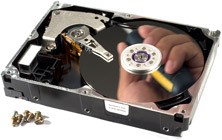Understanding Managed Services
As a definition, Managed Services allows a business to offload IT operations to a service provider, known as a Managed Services Provider. The managed service provider assumes an ongoing responsibility for 24-hour monitoring, managing and/or problem resolution for the IT systems within a business.
A Brief History of Managed Services
The following is a summarized history of managed services to give you some background relating to how these services have developed. This history pertains specifically to companies who service small network systems.
It all started with break-fix services

The Break Fix Mentality
The companies who have helped service small networks in the past have been hamstrung by the lack of tools to help with the problem. The networks they service developed as simple systems, usually built by a self taught network amateur-turned-pro. Maintenance was break-fix only, meaning when something broke, the company called and they came running to fix it… hopefully.
As time went on, the best of the support people developed procedures and programs to periodically come on-site to do a system review of logs and user information looking for hints of issues before they became big problems. In some cases an elaborate checklist was used to record disk usage, processor usage, etc.
The problem of course, was that the support people could only see what was happening on that particular day. If something happened later, they would never know about it … unless the customer called.
Backup problems and other errors continued to occur
Additionally, the only professional test of the backup system was on the visit, which frequently resulted in days or more of missed backups. The system was prone to other human errors when the on-site technician, trying to be accommodating, would take care of the “end user” symptoms and would not have time to address the “real issues”. This created a constant battle for the tech as they tried to convince customers that they were only causing themselves more dangerous problems down the road by not being proactive.
Managed Services began with Fortune 500 companies and their huge networks

At the same time, the hardware and software vendors were adding new and better ways for the systems to signal problems as early as possible. Simple Network Management Protocol had been developing since the early 90’s and was being applied to PC’s. The first systems that could watch these tools and turn all the data into usable information were complex to manage, were geared only to large networks, and were prohibitively expensive for small business.
In 2005, systems started to mature that allowed smaller companies to take advantage of the same features and benefits as the large companies. This technology started the Managed Services movement.
Finally, Managed Services was available for small to medium sized businesses
The Managed Services software that is in place today allows providers to work towards two major goals:
1. Everything on your network that will result in a user symptom or risk will send an alert before or when it happens, and the Managed Service Provider will know about it.
2. Every alert they get is something important and needs to be addressed.
The more closely a Managed Service provider can get to these two goals, the more perfectly they can achieve a truly managed service and the more they can get away from “everything being an emergency” situation.
Why the hype with Managed Services?
Just like larger companies, small businesses need technology to operate efficiently and to compete effectively. But as reliance on IT grows, the resources needed to support this increasingly complex IT environment may not. In many small businesses, IT resources are limited and can be quickly overwhelmed.
If you fall behind in keeping up with things such as backups, patches and security, the odds greatly increase that you’ll face an IT outage or another problem down the road that will negatively impact your business. For instance, if your Email server, customer relationship management system, financial application or network goes down, you will likely face substantial productivity and revenue losses as a result.
Managed Services vs. The Break-Fix Mentality
Managed services are also a philosophical change in the way that a business deals with its technology. Instead of following the old-school tradition of break-fix (literally meaning wait until the server, desktops or other critical networking devices fail, then scramble to fix them), a business operating with a managed service focuses on the prevention of these issues before they disrupt employees, management and/or clients.
Why Break-fix is no longer good enough for your business
A Break-fix maintenance service fixes problems as they crop up. This means that something needs to go wrong before you receive any service, resulting in an inevitable reduction in IT system performance while you wait for the problem to be fixed.
Today, no business can really afford the risk and uncertainty of relying on a “Break-fix maintenance service” because your business is too dependent on having a reliable IT system. Furthermore, having separate suppliers responsible for different parts of the system puts you in the difficult position of trying to decide who should be delivering the service you require. You simply do not have time for this.
Do Managed Services Cost More Than Traditional Break-Fix Services?

Actually no!
Surprisingly most managed services cost less than traditional break-fix services, especially when including the true cost of downtime. Remote monitoring, remote maintenance and the prevention of major issues allow a managed services provider to be more efficient than a similar break-fix company who is constantly rolling a truck to visit customer sites. Therefore the managed service company can offer a “better” service without charging more.
